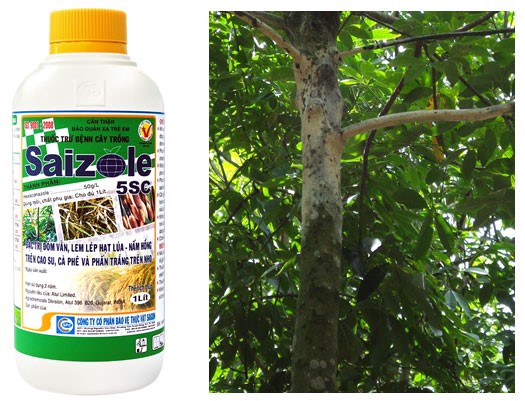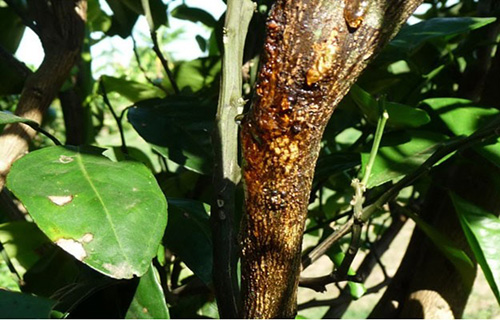|
PINK DISEASE CAUSING DAMAGE ON RUBBER TREE
21/06/2023
PINK DISEASE CAUSING DAMAGE ON RUBBER TREE 23/05/2022 Pink disease commonly causes diseases on rubber plantations in the rainy season, especially on garden from 4-8 years old. This year, rubber has to go through a period of severe drought, weakening the tree, so now in tnshe rainy season it is easy to get infected. Therefore, it is necessary to pay attention to good management to avoid affecting the garden. * Symptoms and effects: Initially the fungus has a white coating on the surface of the bark. When the disease is severe, the fungus turns pink. The disease damages the bark, so the branches or stems above the diseased area die, and below the diseased area, shoots often grow. The bark where gets diseased is usually oozes latex. The disease usually appears on the stem where the branches are branching. The disease causes death of branches or truncation of rubber tops, affecting the uniformity and overall yield of the whole garden. * Harmful agents and arising conditions: The disease is caused by Corticium salmonicolor fungus . The disease develops in the rainy season, especially in the months with a lot of rain . In hot and humid conditions, the fungus thrives. The rubber gardens are over-applied with nitrogen fertilizers, are dense, weeds are abundant and the humidity is high, or the rubber gardens are poorly cared for, and the trees are weak, so their resistance is often severely damaged. * A number of integrated prevention and treatment measures have been applied and shown to be highly effective: Plant at an appropriate density, and do not create canopy , rubber trees is too low During the rainy season, regularly clean the garden, except for weeds and prune dead and ineffective branches to create ventilation in the garden. Diseased branches should be destroyed. A good drainage system is required. Fertilize to avoid excess nitrogen, need to increase potassium fertilizer. Should use more foliar fertilizers such as MULTI-K, or micronutrient fertilizer POLY FEED 15-15-30, spread CALCIUM NITRATE fertilizer to improve soil. These fertilizers will help strengthen the plant resistance and increase yield and quality of latex. In the rainy season, it is necessary to spray preventively with products such as: SAIPORA 350SC (mixed with 200-500ml/100 liters of water), or SAIZOLE 5SC (mixed with 200-250ml/100 liters of water), or VANICIDE 5SL (mixed with 500ml/100 liters of water).Pay attention to spray on branches on the trunk (where water is easy to stagnate) to prevent disease. When the plant starts to get diseased, it is possible to spray or mix with product on the diseased stem. Regularly check the garden during the rainy season, to detect diseased plants and promptly handle them, in order to reduce damage and reduce the cost of prevention. Particular attention should be paid to orchards with a history of infection. Prevention needs to be carried out on a large scale to be effective. Therefore, it is necessary to pay attention to disease prevention for rubber gardens and adjacent perennial fruit orchards. Mobilize rubber plantations in the region to prevent and control disease to limit the accumulation of disease sources and avoid mutual spread.
|
To prevent, in addition to plowing and burying weed seeds, collecting weed stalks and stumps left after tilling the land to burn, not letting weeds produce seeds in production fields, etc., the use of chemical products is still a measure. optimal because of its ability to thoroughly kill weeds, reduce labor and take advantage of more time than manual weeding.
Miner has the scientific name Phyllocnistis citrella Staint., family Phyllocnistidae, order Lepidoptera. The miner occurs in many countries in the tropics and subtropics. The main host of the miner is the citrus family - Rutaceae. In addition, the miner also attacks mangosteen and some other plants.
Adult is a small planthopper, with a body 2-3 mm long, the whole body is ash gray, slightly greenish, the wings are opaque with many small brown spots.Eggs are oval, 0.3 mm long, have a pointed end and are attached directly to the leaf surface, leaf axils.
Green bugs specialize in the fruit of citrus groups (oranges, tangerines, lemons, grapefruits, kumquats...), some people call them orange bugs, or orange suckers. Their scientific name is Rhynchocoris poseidon or Rhynchocoris humeralis.
In Vietnam, yellow leaf curl disease is very common on papaya trees, especially the disease is often severe in areas of high and continuous planting, areas with hot and arid climates. The disease has significantly reduced the yield and quality of papaya. Gardens that are infected early when the plants are young may not yield. However, up to now, many gardeners still do not know the cause and how to fix it.
Spider mites are common pests on citrus trees, especially in hot and dry climates that are suitable for spiders to grow and cause severe damage.The group of harmful spiders is usually very small in size, unlike the natural enemy spiders.
This group includes species that are generally very small in size, causing damage by sucking plant sap (on leaves, fruits, branches, stems).
There are many species of mealybugs present on the group of Oranges,Tangerines,Grapefruits and Lemons (Citrus), which can be divided into 2 groups:
+ Group of sticky mealybugs with common varieties such as Lepidosaphes, Aonidiella, Coccus and Saissetia.
+ Group of flower mealybugs with common genera and species such as Pseudococcus, Planococcus and Icerya purchasi.
Dry branches and berries disease often appear to be common damage on coffee gardens during the rainy season. The disease causes death of branchs, dry fruit, severely affects the canopy structure and coffee yield if not paid attention to prevention.
In recent years, the area of citrus has been expanded because it is a fruit tree with high economic efficiency. However, in order to sell at a high price, not only in quality but consumers also require the external beauty of the fruit, so pest management on citrus is a matter of great concern to farmers. The hot season is a favorable condition for thrips to develop and cause damage, affecting the commercial value of fruit.
Currently in Vietnam, the cultivation of citrus trees is playing an important role in the country agricultural production. The benefits of citrus trees have made many farmers rich. However, wherever citrus trees are planted, fissured trunk cracking appears and causes damage. If any gardener is negligent or lacks attention to this disease, the tree will die, even the whole garden.
- Headquarters
- SAIGON PLANT PROTECTION JOINT STOCK COMPANY
- RQ 1, Nguyen Van Quy St., Tan Thuan Ward, HCM City
- Tax code: 0300632232
- Tel: (028) 38 733 295 - 38 732 077
- Fax: (028) 38 733 003 - 38 733 391
- Website: www.spchcmc.vn - Email: info@spchcmc.vn
- SAIGON PLANT PROTECTION COMPANY
- SAIGON PLANT PROTECTION JOINT STOCK ENTERPRISE
- Lot C1-C3 Hiep Phuoc Industrial Park, Hiep Phuoc Commune, HCM City
- Tel: (028) 3873 4089 - Fax: (028) 3873 4086
- Affiliated Unit
-
- Quick Links
- Home
- About us
- Career Opportunities












